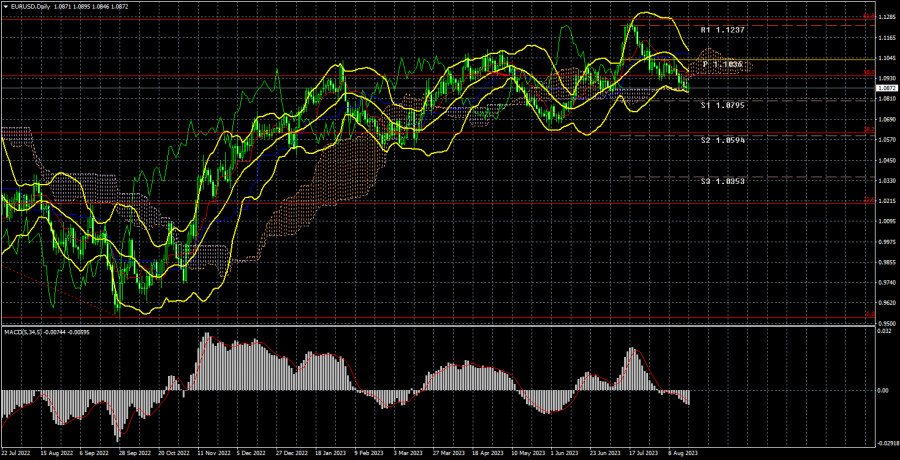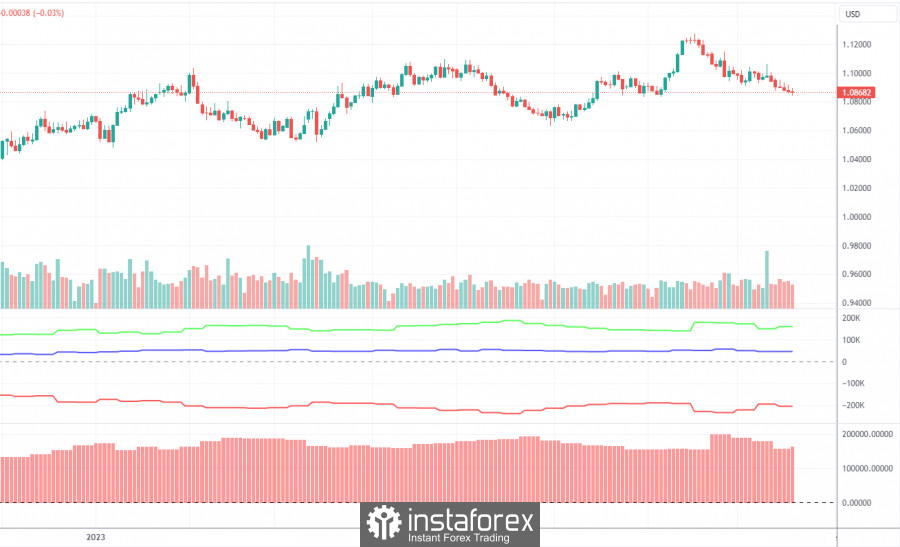Long-term perspective.

The EUR/USD currency pair continued its sluggish decline this week and barely managed to stay below the Ichimoku cloud. However, we would only celebrate for a while. Throughout the week, we repeatedly stated that the downward movement may look quite convincing in the 4-hour timeframe, but it is a mere correction on the daily chart. Moreover, when the price intersects with the Ichimoku cloud, it rises. As a result, the cloud moved up more than the price moved down. It is too early to conclude that the price has stabilized below the Senkou Span B line. The upward trend is in "slumber" but can wake up anytime.
During this week, there were plenty of macroeconomic events in the European Union, but none were significant. There were only important "headlines." For example, on Wednesday, GDP and industrial production reports were published. Sounds ominous? In reality, the GDP report came out with a second estimate, which is the least significant, and its value was similar to the forecast and the previous estimate. Industrial production exceeded forecasts, but what kind of reaction could be expected after this? A 20–30 point increase? On Friday, an inflation report was published, but it was the second final assessment for July, which did not differ from the previous one. There was simply nothing for the market to react to this week. Reports were published in the United States but were not of the first order of importance.
Although we are still skeptical about the correction on the 24-hour timeframe, it should be noted that there is currently only one way for the euro currency to go: down. We see no reason for the resumption of the global upward trend, especially against the backdrop of talks about a possible pause in the tightening of the European Central Bank's monetary policy. The euro remains overbought, has risen too strongly over the past 11 months, and has fallen too weakly within the current correction.
COT analysis.

On Friday, a new COT report was released for August 15th. In the last 11 months, the data from the COT reports fully matched the market developments. In the illustration above, it is clear that the net position of large players (the second indicator) began to grow in September 2022. Around the same time, the European currency began to rise. The net position has hardly increased in the last 6–7 months, but the euro currency remains very high and does not fall. The net position of non-commercial traders is "bullish" and remains strong, and the European currency continues to appreciate against the dollar (in the long term).
We have already pointed out to traders that the relatively high value of the "net position" allows for the assumption of the end of the upward trend. The first indicator signals this, where the red and green lines have significantly moved apart, often preceding the trend's end. During the last reporting week, the number of buy contracts in the "Non-commercial" group increased by 4.4 thousand, while the number of shorts decreased by 5.6 thousand. Accordingly, the net position grew again by 10.0 thousand contracts. The number of buy contracts is higher than sell contracts among non-commercial traders by 160,000, a huge gap and a difference of more than threefold. In principle, even without the COT reports, it is now obvious that the European currency should be declining, but the market is still not in a hurry to sell.
Trading plan for the week of August 21–25:
- In the 24-hour timeframe, the pair worked off the Fibonacci level of 61.8% (1.1270) and began a downward correction. The price has crossed the critical line, so opening long positions is recommended with new buy signals. There was no rebound from the Fibonacci level of 50.0% nor the Senkou Span B line. Therefore, there is currently no reason to buy. There are also no fundamental reasons to expect the strengthening of the European currency.
- As for selling the euro/dollar pair, it is now clearly more promising. The main thing now is to overcome the Ichimoku cloud confidently; in this case, the fall can continue with targets we mentioned a few months ago - levels 5 and 6. The Fibonacci level of 38.2% also lies there, which will attract the price as it is important. The fall may be unhurried and not strong, as volatility is already quite low on the lower timeframes. Nevertheless, we still advocate for a continuation of the euro currency's decline.
Explanation of illustrations:
Support, resistance, and Fibonacci levels are targets when opening purchases or sales. Near them, you can place Take Profit levels.
Ichimoku indicators (standard settings), Bollinger Bands (standard settings), MACD (5, 34, 5).
Indicator 1 on COT charts – the size of the net position of each category of traders.
Indicator 2 on COT charts – the size of the net position for the "Non-commercial" group.
The material has been provided by InstaForex Company - www.instaforex.comfrom Forex analysis review https://ift.tt/97awBPy
via IFTTT
